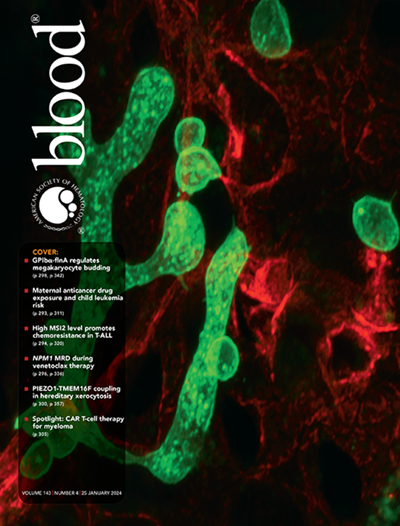我如何治疗:在免疫治疗时代重新审视急性淋巴细胞白血病第二次缓解的神话。
IF 21
1区 医学
Q1 HEMATOLOGY
引用次数: 0
摘要
2013年,我们发表了题为“急性白血病第二次缓解的神话”的观点,强调了成人复发急性白血病的悲惨结局。我们强调,只有少数患者在复发后获得第二次完全缓解(CR2),并随后有资格接受潜在治愈的异体造血干细胞移植(HSCT)。因此,我们敦促白血病社区在首次完全缓解(CR1)时不要延迟HSCT,以避免可怕的后果。从历史上看,不良的结果是由于次优一线治疗、不充分的风险分层和缺乏有效的药物来实现CR2。在过去的十年中,急性白血病的治疗模式取得了显著的进展,最明显的是b细胞急性淋巴细胞白血病。关键的进展包括改进一线治疗,结合早期免疫治疗,基于分子谱分析和可测量残余疾病评估的疾病风险分层改进,以及发现高效的补救性免疫疗法。这些创新导致一线治疗的高治愈率,对高危患者进行CR1期HSCT的精确选择,以及对CR2期患者进行HSCT的现实。在这里,鉴于该领域的进展,我们重新审视CR2的神话。本文章由计算机程序翻译,如有差异,请以英文原文为准。
How I Treat: Revisiting the myth of second remission in acute lymphoblastic leukemia in the era of immunotherapy.
In 2013, we published a perspective entitled, "The myth of the second remission of acute leukemia," which underscored the dismal outcomes of relapsed acute leukemia in adults. We emphasized that only a minority of patients achieved second complete remission (CR2) after relapse and were subsequently eligible to receive a potentially curative allogeneic hematopoietic stem cell transplantation (HSCT). Hence, we urged the leukemia community not to delay HSCT in first complete remission (CR1) if indicated to avoid dire outcomes. Historically, poor outcomes resulted from suboptimal frontline therapy, inadequate risk stratification, and lack of effective agents to achieve CR2. In the past decade, remarkable progress has been made in the treatment paradigm of acute leukemia, most evidently in B-cell acute lymphoblastic leukemia. Key advancements include refinement of frontline treatment, incorporation of early immunotherapy, improved disease risk stratification based on molecular profiling and assessment of measurable residual disease, and discovery of highly effective salvage immunotherapies. These innovations have led to a high rate of cure by frontline therapy, precise selection for HSCT in CR1 for high-risk patients, and the reality of HSCT for patients in CR2. Here, we reexamine the myth of CR2 given the progress in the field.
求助全文
通过发布文献求助,成功后即可免费获取论文全文。
去求助
来源期刊

Blood
医学-血液学
CiteScore
23.60
自引率
3.90%
发文量
955
审稿时长
1 months
期刊介绍:
Blood, the official journal of the American Society of Hematology, published online and in print, provides an international forum for the publication of original articles describing basic laboratory, translational, and clinical investigations in hematology. Primary research articles will be published under the following scientific categories: Clinical Trials and Observations; Gene Therapy; Hematopoiesis and Stem Cells; Immunobiology and Immunotherapy scope; Myeloid Neoplasia; Lymphoid Neoplasia; Phagocytes, Granulocytes and Myelopoiesis; Platelets and Thrombopoiesis; Red Cells, Iron and Erythropoiesis; Thrombosis and Hemostasis; Transfusion Medicine; Transplantation; and Vascular Biology. Papers can be listed under more than one category as appropriate.
 求助内容:
求助内容: 应助结果提醒方式:
应助结果提醒方式:


